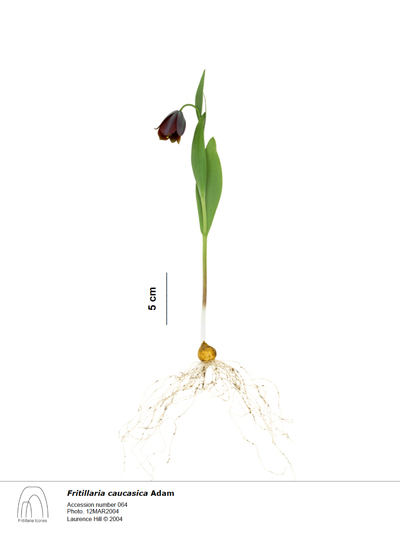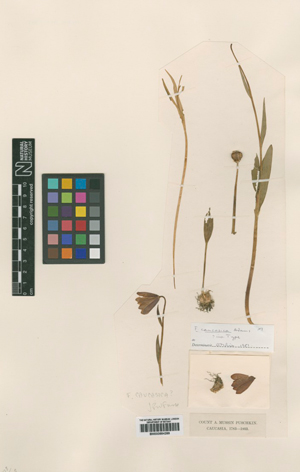Fritillaria caucasica
Fritillaria caucasica was described in 1805 from specimens collected around the springs of Constantinomontanas, particularly on Beshtau, an outlier of the Caucasus, near Pyatigorsk; later the area became popular with the Russian aristocracy who came to take the waters, and with army officers on leave from fighting the Chechens, who came to enjoy the spa society; Lermontov described the view from Pechorin’s lodgings in A Hero of our Time, in the story Princess Mary “..to the west lies Beshtau, with its five blue peaks, like the last cloud of the dying storm”.
This small, dark-flowered fritillary is easily recognised by its long, slender style, thin purple anther filaments and few leaves, which are usually only 3 or 4 in number. A good specimen is a very beautiful if unshowy plant, with a tall slender stem and a single rather rounded flower, curving in at the mouth, with a blue-grey plum-like bloom outside, dark-reddish purple inside. A lovely example, which originated from seed from Leningrad Botanical garden, was painted by Rory McEwen, and is shown in the Edinburgh catalogue of his botanical paintings, plate 73.
Fritillaria caucasica has been found from the northern Caucasus, westwards to northern Turkey near Ladik on the Black Sea coast, and eastwards to Lenkoran in Azerbaijan and in NW Iran, near the border north of Tabriz. It is a plant of subalpine meadows, openings in pine forest and shady, moist, peaty rock ledges on limestone in drier areas. I have not seen living specimens from high meadows of the main range of the Caucasus, where F. latifolia and F. collina are frequent, but I have seen F. caucasica on the grassy slopes above lake Erevan, and in grassy places among Pinus sylvestris near Sarikamiş.
The most perfect forms of Fritillaria caucasica have glabrous styles and filaments, but papillose styles and filaments are commoner over all the southern part of the species range. Plants with thicker, papillose styles, and flowers which are pale greenish or yellowish inside, are common in parts of northeastern Turkey and Azerbaijan; they appear to be intermediates between F. caucasica and F. assyriaca or F. pinardii. They also differ from pure caucasica in having more leaves and more cylindric, less rounded flowers.
In May 1970 I studied in detail the fritillaries on Tahir Dag in NE Turkey. No fewer than six species grow on this pass, close to one another, but mostly separated. Fritillaria caucasica is found on stable saddles which support open grassland with oxlips and buttercups, kept ungrazed and cut for hay; F. armena is found in the bare stony soil in hollows where snow lies late, and it is in places accompanied by F. michailovskyi; F. assyriaca grows on loose earthy slopes and screes, among large umbellifers and other herbs; an intermediate with tall stems, slightly channelled leaves and dark flowers with thick styles grows in sparse grassland, intermediate between the habitats of caucasica and assyriaca and combines characters of these two. I have seen similar plants fron near Sarikamis and the slopes of mount Ararat. The sixth species recorded from Tahir dag is F. crassifolia subsp. crassifolia, which is rare and confined to mobile screes.
Another intermediate is common in Armenia and also occurs in NE Turkey; this has narrowly bell-shaped flowers, greenish inside, slender entire styles, and a shorter stem than Fritillaria caucasica. Both these now occur in areas where one or other parent is absent, and can increase vegetatively as well as by seed.
Fritillaria armena var. lucida was described by Haussknecht & Bornmuller from northern Turkey near Amasya, and is similar to the collection from Ladik, made by Tobey. It is ususual in that the flowers were described as being without the usual glaucous bloom, but otherwise is typical F. caucasica. It is a fine plant which would be worth introducing to cultivation.
Cultivation
Fritillaria caucasica grows best in a cool position and a rich, peaty but well-drained soil, without too much drying in winter. It is very hardy, growing as it does on the mountains above Erzurum, and although, in cultivation, it may emerge in winter, it can survive hard frost. It is very slow to increase vegetatively, so should be raised from seed, if possible from a wild source.
Fritillaria caucasica J.F. Adam in Weber & Mohr, Beitr. Naturk. 1:51 (1805).
Synonym:F. tulipifolia Bieb., Fl. Taur. Cauc. 1: 270(1808).
F. armena Boiss. var. lucida Hausskn. & Bornm. in Mitt. Thür. Bot. Ver. n.s.20: 47(1905).
Description
Bulb to 2cm across, bulbils not seen. Stem 10-20cm, smooth. Leaves glaucous, lanceolate, 2-4, rarely to 6, all alternate,the lowest 3-10 x 0.8-2cm, the rest shorter and narrower. Flower solitary, purplish-black, with a grey bloom outside, not tessellated, dark purple or sometimes greenish inside, rounded campanulate, usually narrowed at the mouth, with the tips of the tepals spreading. Tepals 2.2-3cm, rarely to 3.7cm long, 5-12mm wide, the inner slightly wider, 6-14mm. Nectary 4-5 x 1mm, linear-lanceolate, green, at the base of the tepal. Filaments 10-18mm, slender, smooth or sparsely papillose, usually purplish. Style 9-17mm, undivided, slender, smooth or sparsely papillose. Capsule cylindric, not winged.
Chromosome Number: 2n = 24 [Khaniki, G. B. 2002. Chromosome Numbers of all Iranian Species of Fritillaria caucasica Group (Liliaceae) in Nucleus 45(3): 103-108.]
Habitat: In alpine and subalpine meadows, clearings in pine or oak forest and on limestone rock ledges
Distribution: S. Russia near Pyatigorsk, Georgia, Armenia, N & NE Turkey, NW Iran, Azerbaijan.
Flowering period: April-June
Extract from Martyn Rix’s forthcoming Monograph ©2008
Type: Russia, ad thermas Constantinomontanas [in promontoris, Caucasi borealis], Mussin-Puschkin (holo. LE, iso. BM).
![]()




